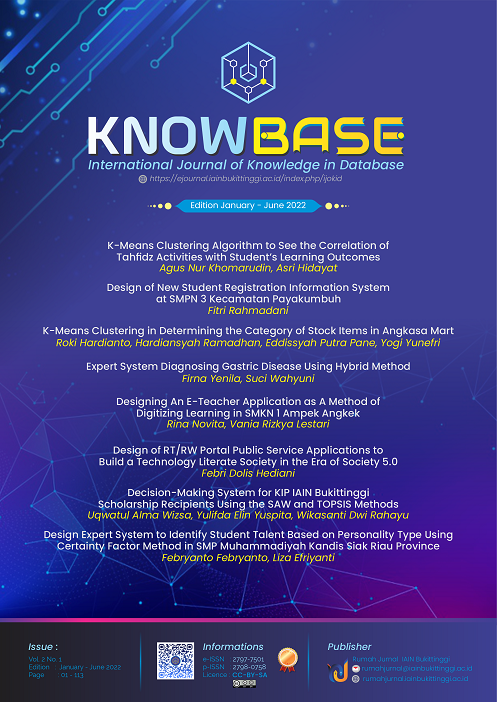Design of New Student Registration Information System at SMPN 3 Kecamatan Payakumbuh
DOI:
https://doi.org/10.30983/ijokid.v2i1.5259Keywords:
Information System, PPDB, R&D, Method Waterfall, Development Model, PHP/MySqlAbstract
In this research, the author encountered some problems with PPDB (admission of new students) in SMP N 3 Kecamatan Payakumbuh, as there was no website for new student registration. As a result, the announcement about the PPDB was announced through brochures. Sometimes, this makes a problem, such as a brochure was lost or torn. Therefore, there were obstacles to administration and information about the PPDB, it made inefficient. Another problem was that there was no data stored in the database, which made data vulnerable to lose and easily burned. Research and Development (R&D) with the system development model used is SDLC (System Development Life Cycle), which consists of 5 stages, namely Communication, Planning, Modeling, Construction dan Deployment. When planning‎[1], the ACON student information system was built using PHP/MySql. The research was tested using a validity test with three validators, and the system was declared valid with an average of 0.78. Furthermore, the system was declared very practical with an average of 0.97 after being tested on three teachers. At last, the effectiveness test was conducted on 5 students, and the system received a very high effectiveness score of 0.87 on average‎.
References
D. Nataniel and H. R. Hatta, “Perancangan Sistem Informasi Terpadu Pemerintah Daerah Kabupaten Paser,†J. Inform. Mulawarman, vol. 4, no. 1, pp. 47–54, 2009, doi: 10.30872/jim.v4i1.27.
L. Efriyanti and F. Annas, “Aplikasi Mobile Learning Sebagai Sarana Pembelajaran Abad 21 Pada Era Revolusi Industri 4.0,†J. Educ. Stud., vol. 5, no. 1, p. 40, 2020, doi: http://dx.doi.org/10.30983/educative.v5i1.3132.
J. S. Pasaribu, “Penerapan Framework Yii Pada Pembangunan Sistem Ppdb Smp Bppi Baleendah Kabupaten Bandung,†J. Ilm. Teknol. Infomasi Terap., vol. 3, no. 2, pp. 154–163, 2017, doi: 10.33197/jitter.vol3.iss2.2017.132.
I. A. Pamungkas and N. N. Rofiq, “Analisis Dan Perancangan Aplikasi E-Learning Berbasis Web Pada Madrasah Ibtidaiyah,†J. Tek. Inform., vol. 22, no. 2, pp. 1–13, 2014, doi: https://jdih.perpusnas.go.id.
H. Mujiati and Sukadi, “Analisis Dan Perancangan Sistem Informasi Stok Obat Pada Apotek Arjowinangun,†J. Bianglala Informatika, vol. 4, no. 1, pp. 11–15, 2016.
Fitria, “Sistem Pendidikan Nasional,†in Journal of Chemical Information and Modeling, vol. 3, no. 9, 2013, pp. 1689–1699.
Z. Marzuki and H. A. Musril, “Perancangan Sistem Informasi Akademik Siswa Menggunakan Code Igniter 3 di SMKN 4 Payakumbuh,†J. Edukasi Elektro, vol. 5, no. 1, pp. 49–55, 2020.
P. Astuti, “Penerapan Metode Waterfall Dalam Pembuatan Sistem Informasi Dana Kas Kecil Pada Pt. Natur Pesona Indonesia,†J. Sains dan Manaj., vol. 8, no. 1, pp. 36–45, 2020, doi: 10.31294/evolusi.v8i1.7461.
M. Syarif and E. Bayu Pratama, “Implementasi Waterfall Sebagai Metode Pengembangan Perangkat Lunak Administrasi Kepegawaian Pada Swalayan,†J. Inform. Kaputama(JIK), vol. 5, no. 1, pp. 174–184, 2021.
A. Adil and B. K. Triwijoyo, “Perancangan Sistem Informasi Pemasaran Produk,†Peranc. Sist. Inf. Pemasar. Prod. Kerajinan Di Pulau Komodo, vol. 7, no. 2, pp. 166–171, 2016, [Online]. Available: https://journal.universitasbumigora.ac.id/index.php/semnastikom2016/article/view/102.
N. Dewara and M. Azhar, “Validitas dan Praktikalitas Modul Larutan Penyangga Berbasis Guided Discovery dengan Mengunakan Tiga Level Representasi Kimia untuk Kelas XI SMA,†Edukimia, vol. 1, no. 1, pp. 16–22, 2019, doi: 10.24036/ekj.v1.i1.a10.
M. R. Darmawan and H. A. Musril, “Perancangan Sistem Pendaftaran Audiens Seminar Proposal di Institut Agama Islam Negeri (IAIN) Bukittinggi,†J. Teknol. dan Inf., vol. 11, no. 1, pp. 26–39, 2021, doi: 10.34010/jati.v11i1.3346.
B. Setiawan, “Penerapan Komputer dalam dunia revolusi 4.0,†J. Inform., vol. 3, no. 2009, pp. 1–14, 2001.
S. Derta, “Desain sistem informasi kedisiplinan siswa di Sekolah Menegah Kejuruan Negeri 1 Bukittinggi.,†J. Ilm. Inform., vol. 4, no. 2, pp. 34–48, 2020.
Downloads
Published
How to Cite
Issue
Section
Citation Check
License
Copyright (c) 2022 Fitri Rahmadani

This work is licensed under a Creative Commons Attribution-ShareAlike 4.0 International License.
Authors who publish with this journal agree to the following terms:
- Authors retain copyright and grant the journal right of first publication with the work simultaneously licensed under a Creative Commons Attribution License that allows others to share the work with an acknowledgment of the work's authorship and initial publication in this journal.
- Authors are able to enter into separate, additional contractual arrangements for the non-exclusive distribution of the journal's published version of the work (e.g., post it to an institutional repository or publish it in a book), with an acknowledgment of its initial publication in this journal.
- Authors are permitted and encouraged to post their work online (e.g., in institutional repositories or on their website) prior to and during the submission process, as it can lead to productive exchanges, as well as earlier and greater citation of published work (See The Effect of Open Access).



